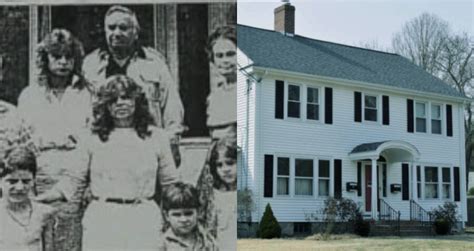The Haunting in Connecticut, a film released in 2009, is based on the alleged true story of the Snedeker family, who claimed to have experienced paranormal activity in their home in Southington, Connecticut. The story, as depicted in the film and other media, is a blend of fact and fiction, leaving many to wonder about the accuracy of the events described. To explore this further, it’s essential to delve into the history of the house, the experiences of the Snedeker family, and the investigations that followed.
The Snedeker family moved into the house on Meriden Avenue in Southington, Connecticut, in 1974. The house had previously been used as a funeral home, which the family was aware of before purchasing the property. Shortly after moving in, the family began to experience strange occurrences, including unexplained noises, movements, and sightings. The family’s claims of paranormal activity were widely publicized, catching the attention of paranormal investigators Ed and Lorraine Warren, who were instrumental in popularizing the story.
One of the primary concerns when evaluating the accuracy of the Haunting in Connecticut is the role of the Warrens. Ed and Lorraine Warren were well-known paranormal investigators, but their methods and conclusions have been questioned by many experts. The Warrens’ investigation of the Snedeker house involved a series of interviews with the family and observations of the property. However, their findings were not scientifically verified, and many of their conclusions were based on the family’s testimony and their own interpretations of the events.
The Snedeker family’s experiences, as reported, included a wide range of paranormal phenomena, from moving objects and unexplained noises to sightings of ghostly apparitions. The family claimed that the activity was intense and pervasive, making it difficult for them to live in the house. However, when examining the family’s claims, it’s crucial to consider the psychological and emotional factors that may have contributed to their perceptions. The family was under significant stress due to their son’s illness, and the funeral home’s history may have contributed to their expectations and experiences.
In terms of the film’s accuracy, it’s essential to note that the movie takes creative liberties with the story. The film’s depiction of the events is sensationalized and condensed for dramatic effect, which can make it difficult to separate fact from fiction. While the film is based on real events, it should not be considered a documentary or a historically accurate retelling of the story.
To gain a deeper understanding of the Haunting in Connecticut, it’s necessary to examine the various investigations and evidence collected. The Warrens’ investigation, as well as other paranormal investigators, collected a significant amount of data, including audio recordings, photographs, and eyewitness testimony. However, much of this evidence is anecdotal and has not been scientifically verified. The lack of concrete evidence and the reliance on testimony make it challenging to confirm the accuracy of the events described.
In conclusion, the Haunting in Connecticut is a complex and multifaceted story that blends fact and fiction. While the Snedeker family’s experiences are well-documented, the accuracy of the events described is difficult to verify. The role of the Warrens, the psychological and emotional factors, and the lack of concrete evidence all contribute to the uncertainty surrounding the story. As with any paranormal claim, it’s essential to approach the story with a critical and nuanced perspective, recognizing both the potential for unknown phenomena and the limitations of human perception.
What is the true story behind the Haunting in Connecticut?
+The true story behind the Haunting in Connecticut involves the Snedeker family's experiences in their home in Southington, Connecticut. The family claimed to have experienced paranormal activity, which was investigated by paranormal investigators Ed and Lorraine Warren.
How accurate is the film's depiction of the events?
+The film takes creative liberties with the story, sensationalizing and condensing the events for dramatic effect. While the film is based on real events, it should not be considered a documentary or a historically accurate retelling of the story.
What evidence supports the paranormal claims?
+The evidence supporting the paranormal claims includes audio recordings, photographs, and eyewitness testimony. However, much of this evidence is anecdotal and has not been scientifically verified.
What are the psychological and emotional factors that may have contributed to the family's experiences?
+The family was under significant stress due to their son's illness, and the funeral home's history may have contributed to their expectations and experiences. These factors can contribute to a heightened sense of awareness and sensitivity to potential paranormal activity.
How can I learn more about the Haunting in Connecticut?
+To learn more about the Haunting in Connecticut, you can start by researching the Snedeker family's experiences and the investigations that followed. You can also explore the history of the house and the funeral home, as well as the psychological and emotional factors that may have contributed to the family's experiences.
What are the implications of the Haunting in Connecticut for our understanding of paranormal activity?
+The Haunting in Connecticut has significant implications for our understanding of paranormal activity. The story highlights the complexity and nuance of paranormal claims, emphasizing the need for a critical and nuanced approach to investigating these phenomena.
In exploring the Haunting in Connecticut, it’s essential to consider the historical context of the events. The story takes place in the 1970s, a time when paranormal activity was a topic of significant interest and debate. The Snedeker family’s experiences, as well as the investigations that followed, reflect the cultural and societal attitudes towards the paranormal during this period.
To further understand the Haunting in Connecticut, it’s necessary to examine the theoretical frameworks that underlie paranormal activity. The concept of haunting, in particular, is rooted in the idea that certain locations can be imbued with a residual energy or presence. This energy can manifest in various ways, including unexplained noises, movements, and sightings.
In conclusion, the Haunting in Connecticut is a complex and multifaceted story that challenges our understanding of paranormal activity. The story highlights the need for a critical and nuanced approach to investigating these phenomena, recognizing both the potential for unknown phenomena and the limitations of human perception. By examining the historical context, theoretical frameworks, and evidence supporting the paranormal claims, we can gain a deeper understanding of the Haunting in Connecticut and its implications for our understanding of the paranormal.
Step-by-Step Guide to Investigating Paranormal Activity

- Research the history of the location and potential previous paranormal activity.
- Conduct interviews with witnesses and individuals who have experienced paranormal activity.
- Collect and analyze evidence, including audio recordings, photographs, and eyewitness testimony.
- Evaluate the psychological and emotional factors that may have contributed to the experiences.
- Consider alternative explanations for the paranormal activity, including natural causes and human error.
- Draw conclusions based on the evidence and analysis, recognizing the limitations and uncertainties of paranormal investigation.
The Haunting in Connecticut serves as a reminder that paranormal activity is a complex and multifaceted phenomenon that challenges our understanding of the world. By approaching these phenomena with a critical and nuanced perspective, we can gain a deeper understanding of the underlying mechanisms and implications for our understanding of reality.
In the end, the Haunting in Connecticut remains a captivating and thought-provoking story that continues to fascinate audiences. Whether or not the events described are entirely accurate, the story highlights the power of the human imagination and our desire to understand the unknown. As we continue to explore the paranormal and the unexplained, we must remain mindful of the complexities and nuances of these phenomena, recognizing both the potential for unknown phenomena and the limitations of human perception.



